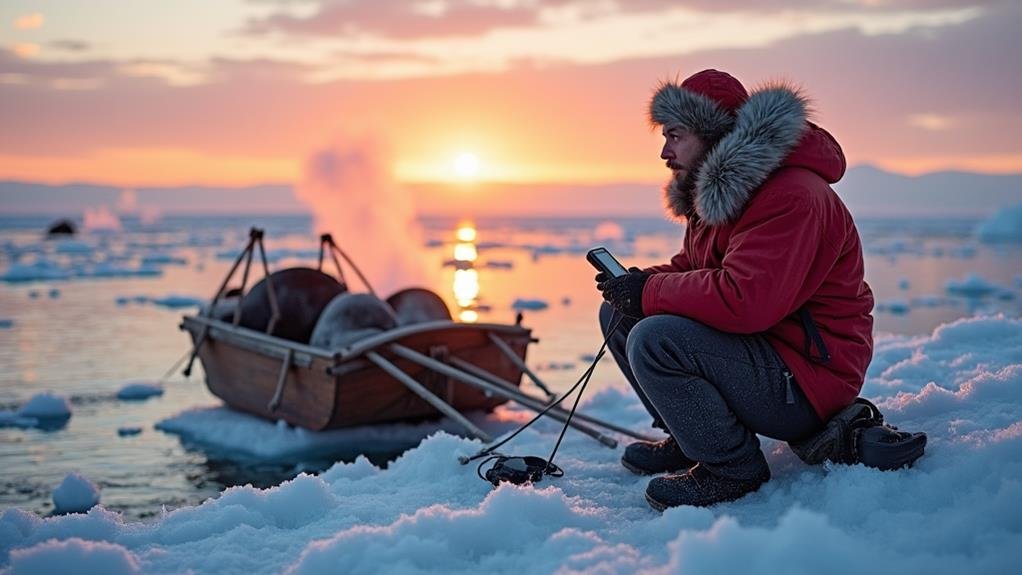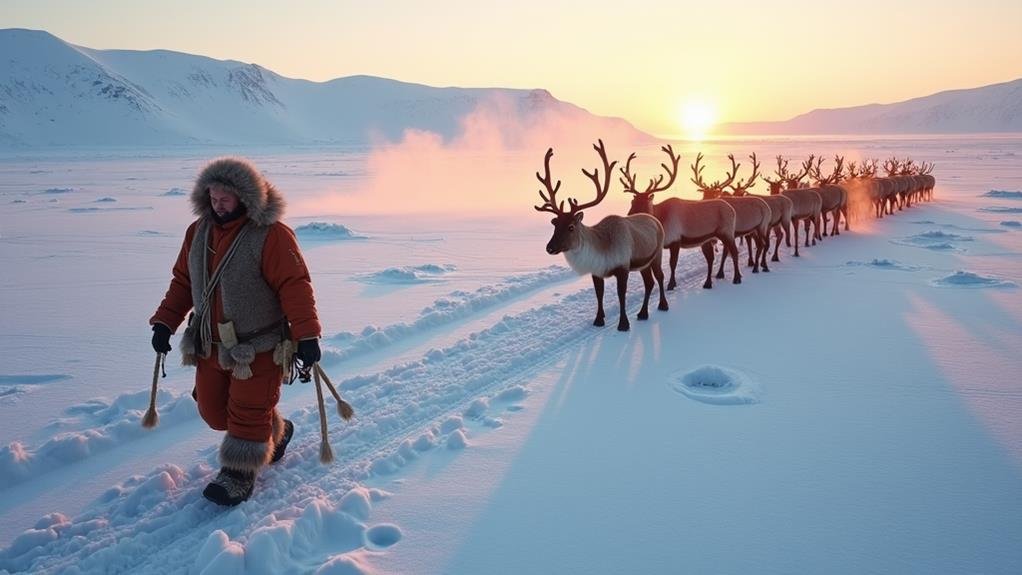The Arctic's delicate ecosystem hasn't survived by chance. For generations, Inuit communities have maintained a harmonious relationship with their environment through carefully refined hunting and fishing practices that modern conservationists are only beginning to understand. Today's environmental challenges have brought renewed attention to these traditional methods, which offer valuable insights into sustainable resource management. As climate change threatens Arctic wildlife and traditional ways of life, the intersection of ancient knowledge and contemporary conservation practices presents both opportunities and complexities that demand closer examination.
Main Points
- Inuit traditional knowledge combines centuries of ecological understanding with sustainable hunting practices to maintain Arctic ecosystem balance.
- Community-based wildlife monitoring systems blend ancestral wisdom with modern conservation techniques for effective resource management.
- Seasonal hunting patterns adapt to environmental changes while ensuring food security and cultural preservation.
- Traditional hunting practices emphasize resource sharing and community feasts, promoting equitable distribution and social cohesion.
- Inuit-established Protected Areas spanning 15,000 sq km demonstrate successful integration of conservation goals with traditional resource use.
Traditional Knowledge Meets Modern Conservation
The Inuit people's ancestral knowledge of Arctic ecosystems has proven essential in bridging traditional hunting practices with modern conservation efforts. Their deep ecological understanding, passed down through generations, continues to inform sustainable development strategies that protect marine resources while maintaining cultural practices.
Inuit communities demonstrate remarkable adaptability by combining traditional knowledge with contemporary conservation needs. Their detailed observations of wildlife behavior and sea ice patterns help establish effective protected areas that serve both conservation goals and community needs. This integration of Indigenous peoples' expertise with scientific research has created more thorough approaches to marine conservation.
As climate change threatens Arctic ecosystems, the collaboration between Inuit knowledge holders and scientists has become increasingly crucial. Traditional hunting practices, guided by centuries of ecological wisdom, now inform adaptive management strategies and monitoring systems. The establishment of Inuit Protected Areas exemplifies this successful merger, where traditional hunting methods coexist with biodiversity protection efforts. Through innovative approaches like eDNA databases and community-based monitoring programs, Inuit traditional knowledge continues to enhance our understanding of Arctic ecosystems and guide sustainable resource management decisions.
Marine Resources and Cultural Identity
Marine resources form the cornerstone of Inuit cultural identity, with three primary activities – hunting, fishing, and sharing – defining their way of life. Traditional practices of hunting reflect the deep connection between Inuit communities and the Arctic ecosystem, as they rely on indigenous knowledge passed down through generations to track and harvest marine mammals sustainably.
The intricate relationship between Inuit communities and marine resources manifests in three key ways:
- Seasonal hunting patterns that adapt to environmental changes and ice conditions, demonstrating remarkable resilience in maintaining food security
- Community feasts and resource sharing that strengthen social bonds and guarantee equitable distribution of harvested marine mammals
- The transmission of traditional ecological knowledge that enables successful navigation of the Arctic's complex marine environment
Today's Inuit hunters face mounting challenges as environmental changes impact marine mammal populations and traditional hunting grounds. These shifts threaten not only their food security but also the preservation of cultural practices that have sustained their communities for generations. Despite these challenges, Inuit communities continue to adapt their traditional practices while maintaining their essential connection to marine resources.
Adapting to Environmental Changes

Significant environmental changes across the Arctic region have forced Inuit communities to rapidly adapt their traditional hunting and fishing practices. With winter temperatures plummeting to -30C along the Nunatsiavut coastline and the loss of approximately 40 snow days annually since 1950, the Inuit community faces unprecedented challenges in maintaining their way of life.
Climate change has disrupted traditional hunting patterns, as late-arriving Arctic ice affects both wildlife movement and hunters' ability to traverse the landscape. In response, Inuit hunters and elders are combining their observational knowledge with scientific data to better understand and adapt to shifts in the marine environment. This knowledge-sharing helps track changes in marine life behavior and ecosystem dynamics.
The establishment of Inuit Protected Areas covering 15,000 sq km represents a vital step toward sustainable use of natural resources while preserving cultural practices. These protected zones help manage new threats, such as invasive species like the European green crab, which impact traditional fishing grounds. Through these adaptive strategies, Inuit communities are working to maintain their cultural heritage while responding to rapid environmental transformation in the Arctic region.
Sustainable Hunting Practices
Sustainable practices form the bedrock of Inuit hunting traditions, extending far beyond mere adaptations to environmental changes. Indigenous knowledge, passed down through generations, enables Inuit hunters to maintain a delicate balance between resource utilization and conservation. Their traditional practices demonstrate a deep understanding of marine ecosystems, guaranteeing the preservation of wildlife populations while meeting community needs for food security.
The Inuit approach to sustainable hunting encompasses three key elements:
- Traditional knowledge integration: Hunters rely on ancestral wisdom to track and harvest animals in ways that maintain healthy population levels
- Community-led conservation: Inuit-established Protected Areas help prevent overexploitation while preserving cultural hunting rights
- Collaborative monitoring: Partnerships between Indigenous communities and researchers strengthen wildlife management strategies
These sustainable practices have proven crucial for both environmental stewardship and cultural preservation. By combining traditional hunting methods with modern conservation approaches, Inuit communities continue to demonstrate how Indigenous knowledge can effectively guide resource management. Their practices guarantee that essential food sources remain available while maintaining ecosystem balance, showcasing a model of sustainability that benefits both people and wildlife.
Arctic Wildlife Management Strategies

While the Arctic faces unprecedented environmental challenges, Inuit communities have developed sophisticated wildlife management strategies that combine traditional knowledge with modern conservation approaches. Through adaptive management practices, they've established flexible hunting schedules and resource-sharing systems that respond effectively to declining wildlife populations and changing ecological conditions.
The Inuit's approach to wildlife management is exemplified by their advocacy for Marine Protected Areas that balance conservation with traditional resource use. Working through organizations like the Arctic Council and the Inuit Circumpolar Council, communities actively participate in decision-making processes that affect marine ecosystems. Their establishment of the first Inuit Protected Area, spanning 15,000 square kilometers, demonstrates their commitment to preserving Arctic wildlife while maintaining cultural practices.
Local hunters and fishers play an essential role in monitoring and managing wildlife populations by sharing their observations of animal behavior and migration patterns affected by climate change. This community-based approach to wildlife management guarantees that traditional knowledge informs conservation efforts, creating a more thorough and effective strategy for protecting Arctic ecosystems while sustaining Inuit livelihoods.
How Does Traditional Inuit Hunting Impact the Decline of Harp Seals in the Arctic?
Traditional Inuit hunting is sustainable and deeply connected to cultural practices. It targets only a small number of harp seals, using methods passed down through generations. These practices do not significantly contribute to population declines. Effective conservation strategies should focus on larger contributors like climate change to reverse harp seal decline.
How Have Inuit Hunting and Fishing Practices Contributed to Their Scientific Understanding of the Arctic Ecosystem?
Inuit hunting and fishing practices have allowed for detailed observations of wildlife patterns, ice conditions, and climate shifts over centuries. These practices, combined with inuit arctic exploration, have provided invaluable knowledge that contributes to modern scientific understanding of the Arctic ecosystem, balancing ecological health with sustainable living methods.
Conclusion
Inuit hunters and fishers serve as nature's custodians, dancing with the rhythm of Arctic life as they've done for countless moons. Their time-honored practices aren't just about gathering sustenance; they're weaving together the fabric of cultural preservation and environmental stewardship. As the northern lights guide their way, these guardians of the tundra continue to embrace both ancestral wisdom and modern conservation, ensuring tomorrow's harvest remains bountiful.


